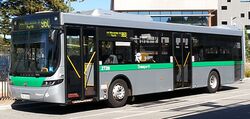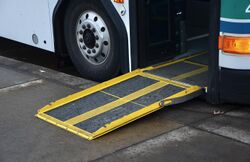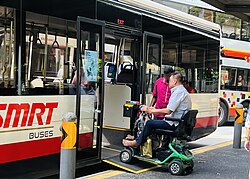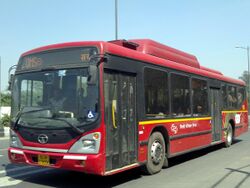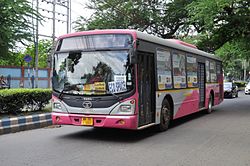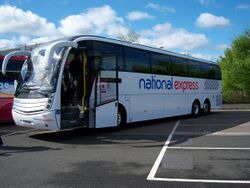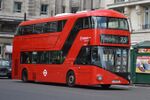Engineering:Low-floor bus
A low-floor bus is a bus or trolleybus that has no steps between the ground and the floor of the bus at one or more entrances, and low floor for part or all of the passenger cabin. A bus with a partial low floor may also be referred to as a low-entry bus or seldom a flat-floor bus in some locations.
Low floor refers to a bus deck that is accessible from the sidewalk with only a single step with a small height difference, caused solely by the difference between the bus deck and sidewalk. This is distinct from high-floor, a bus deck design that requires climbing one or more steps (now known as step entrance) to access the interior floor that is placed at a higher height. Being low-floor improves the accessibility of the bus for the public, particularly the elderly and people with disabilities, including those using wheelchairs and walkers. Almost all are rear-engine, rear-wheel-drive layout.
Configuration
Low-floor and low-entry buses
Low-floor buses are generally divided into two major types: fully low-floor buses with a low floor throughout the length of the bus (more popular in Europe[citation needed]), and low-entry buses with step-free access to only a part of the bus, most commonly between the front door and the middle door (more popular in North America). In North America, both types are commonly called low-floor, as the majority of the vehicle has a low floor, without steps at the doors.
The main reason for choosing a low-entry configuration is to allow better placement for the powertrain and other technical equipment in the raised floor section, in addition to allowing a more comfortable ride on rough roads. Some manufacturers use the initials LF or L in their model designations for fully low-floor models (or in the case of German manufacturers, NF or N, based on the German word Niederflur, which means low floor), and in North America buses that are partially low-floor are often also designated LF. In some countries, LE, short for Low Entry, is used by some manufacturers in their model designations for low-entry buses.
Suspension and powertrain
File:Kneeling bus raising the floor before departure.webm Most bus manufacturers achieve a low floor height by making rear-engined rear-wheel drive buses with independent front suspension, so that no axle is needed to pass under the floor of the front part of passenger compartment, or a lowered front axle. Some full low-floor buses also have a lowered rear axle, while the rear axle is not an issue on a low-entry bus.
Many low-floor buses, including the Irisbus Citelis (also in Skoda 24Tr trolleybus version), have the engine in a vertical cabinet at the rear of the bus. Van Hool have a series of "side-engine mid-drive" buses that puts the engine off to one side of the cabin longitudinally between the first and the second axle, to maximize usable cabin space. The same concept was also utilized by Volvo on their B9S articulated chassis.
For smaller buses, such as midibuses, the low-floor capability is achieved by placing the front wheels ahead of the entrance. One of the last types of buses to gain low-floor accessibility as standard was the minibus, where a similar front-wheel arrangement allows around 12 seats and a wheelchair space to be accommodated in very small low-floor minibuses, such as the Optare Alero and Hino Poncho. Accessibility was previously achieved in paratransit type applications, which use small vehicles with the fitment of special lifts. The inception of small low-floor buses has allowed the development of several accessible demand-responsive transport schemes using standard 'off-the-shelf' buses.
A disadvantage of the low floor is accommodating the bus's own wheels. With the low floor, the wheels protrude into the passenger cabin, and need to be contained in wheel pockets of waist height, and this occupies space which would otherwise be used for seating. To allow space for technical equipment, many low-floor buses have the seats mounted on podiums, making a small step up from the floor, while others are able to mount the seats directly to the floor, avoiding the step. Seating layout for a low-floor bus therefore requires careful design.[1] Low floor configuration is also known to have poor side to side dead load distribution within the chassis due to the asymmetrical off-centre placement of driveline components - mainly engine and transmission. As a result, many of such buses require electronically controlled air suspension to compensate the lopsided configuration.
Other features
Low-floor buses usually include an area without seating (or seating that folds up) next to at least one of the doors, where wheelchairs, walkers, strollers/prams, and where allowed even bicycles, can be parked. This is sometimes not the only purpose of this area, though, as many operators employ larger standee areas for high occupancy at peak times. Despite the space existing, operators may also insist that only one or two wheelchairs or pushchairs can be accommodated unfolded, due to space/safety concerns.
Low floors can be complemented by a hydraulic or pneumatic 'kneeling device', which can be used when the bus is not in motion, tilting it or lowering it at the front axle even further, often down to normal curb height. Depending on how close to the curb the bus is parked and wheelchair design, this can allow wheelchair users to board unaided. Though such technology has been available and in use on high-floor buses since the 1970s, it is of significant utility on low-floor vehicles only where it enables less-mobile passengers to board and leave the vehicle without help from others. Many vehicles are also equipped with wheel-chair lifts, or ramps which, when combined with a low floor, can provide a nearly level entry.
An implementation of the low floor design exists in Australia where custom coaches make a "hybrid" variant of its CB60 bodywork. These buses combine a smaller low floor area with a small underfloor bin for some luggage. Whilst these buses do not provide a full amount of luggage space, they can be used to house more luggage than what can be held inside the bus itself. Another drawback is the arrangement means the section of the bus that is at curb height is very short—consisting of enough space to house the wheelchair area and then rising up, to accommodate the luggage bin. These buses also lack the ability to have a center door.
Alternatives
Many bus rapid transit systems employ a level boarding by using high-floor buses stopping at "station" style bus stops. Specially raised sections of curb may also be used to achieve accessibility with lesser low floor models, although this is more expensive for the operator, and only attractive for regular busy scheduled routes. For infrequent routes or routes with hail and ride sections, or demand responsive transport, raised curbs would only be feasible in terminuses.
Some transit agencies refused to order low-floor buses altogether, such as New Jersey Transit and MUNI owing to terrain conditions in the service area. DART still has a preference for high floor buses. Although New York City Transit runs some 40-foot low-floors, it originally refused to order low-floor buses, namely D60LFs from New Flyer, after the D60HF, a high floor model, was discontinued mid-delivery. [citation needed] However, they have demonstrated both the D60LF and NovaBus LFSA, the latter of which they have decided to order.
Asia
India
Bangalore Metropolitan Transport Corporation Bangalore is one of the first cities in India that introduced Low Floor buses. The Bangalore Metropolitan Transport Corporation, BMTC operates many services using the premium Volvo[2] 8400LE Low-floor buses. These buses are air-conditioned, and offer features such as automatic transmission, kneeling and wheel-chair ramp, typical of modern city buses. They are also fitted with LED display boards as well as ITS to announce the halts. The corporation also had tried Mercedes-Benz Low-Floor buses as well as Ashok Leyland ULE coaches, but chose to stick to the Volvo offering.
In order to keep the bus ticket prices low, the BMTC operates the majority of their services using Non-Airconditioned Semi-Low Floor (SLF) buses that have a floor height of 650mm as against the 400mm floor height of the true Low-Floor buses. These buses are from Ashok Leyland and Tata Motors, with future procurements planned to be from Eicher (VECV). These cheaper alternative to low-floor buses do not have kneeling or wheel-chair accessible ramps, but they have air suspension and use the same or better seats as those found in the Volvo buses. They also feature manual transmission as against automatic transmission
New Delhi
With the introduction of Bus Rapid Transit (BRT) and the development of dedicated corridors for the service, bus service is set to improve.[3] The Delhi Transport Corporation (DTC) has started introducing air-conditioned buses and brand new low-floor buses (with floor height of 400 mm (15.75 in) and even higher on one third area as against 230 mm (9.06 in) available internationally) on city streets to replace the conventional buses.[4] A revamp plan is underway to improve bus-shelters in the city and to integrate GPS systems in DTC buses and bus stops so as to provide reliable information about bus arrivals. The Delhi Government decided to expedite this process and procured 6,600 low floor buses for the DTC before commonwealth games in 2010.
Kolkata
Kolkata has an extensive network of government run buses. Recently air-conditioned buses have been introduced by the WBSTC. These buses connects places like the Kolkata Airport, Barasat (Capital Town of North Suburb), New Town, Salt Lake, Howrah, Santragachi (a station on the Howrah-Kharagpur railway line), Kudghat and Tollygunge. The road network in Kolkata is vast. Under Jawaharlal Nehru National Urban Renewal Mission, air conditioned buses have been included as a part of travel comfort to commuters. Air-conditioned buses are operated by West Bengal Surface Transport Corporation (WBSTC) directly & through outsourcing. These buses are served by Tata Marcopolo Buses and Volvo Low Floor Buses. The V Series and VS series bus routes are served by the AC volvo bus and MW series are served by the Tata Marcopolo buses operated by WBSTC. AC Marcopolo buses serve the MH series route operated by WBHIDCO and the MB series route operated by BHBL. Calcutta State Transport Corporation (CSTC) also run AC Volvo Bus & Ashok Leylan JanBus.
Jaipur (Jaipur)
- Non-AC : Several Non-AC buses are available across the city. There are 10 routes.7 are radial and 10 are circular
- AC: There are six AC routes buses namely AC-1,AC-2, AC-3, AC-5, AC-6 and AC-7. JCTSL operates buses from Ashok Leyland and Tata
Japan
In Japan , a low-floor bus is called "non-step bus (ノンステップバス)". Mitsubishi Fuso Truck and Bus Corporation used to calling a low-floor bus "no-step bus (ノーステップバス)".[5] At Enshu Railway Company in Hamamatsu Area, a low-floor bus is called "omnibus (オムニバス)", "cho-teisho bus (超低床バス; very low-floor bus)" and "cho-teisho omnibus (超低床オムニバス; very low-floor omnibus)". Japanese government calls a low-floor bus "cho-teisho non-step bus (超低床ノンステップバス; very low-floor non-step bus)".
The term non-step bus may also refer to a high floor bus where the floor is flat in order to align with the high platforms in certain Bus Rapid Transit systems. Thereby, referring to it as a non-step high floor bus.
Philippines
The Land Transportation Franchising and Regulatory Board (LTFRB) mandates the use of low-floor or low-entry buses on city bus routes in the Philippines since 2016.
Low-floor buses are used on city bus networks in Metro Manila, Metro Cebu and Davao City, and on some provincial routes.
Singapore
Low-floor wheelchair-accessible buses were introduced in Singapore in 2006 with the entry of Volvo B9TL double-deck chassis buses on SBS Transit service.
Europe
Germany
Low-floor buses are first adopted in Germany in 1989, and to make them easier to use for wheelchairs and strollers, the minimum ground clearance of the entire vehicle is lowered and the floor is proportionately raised by 30 centimetres (12 in) above the road surface.
United Kingdom

The Dennis Dart SLF (Super Low Floor) marked the wholesale introduction of single-deck low floor buses in the United Kingdom in 1995, after many small-scale demonstrator usages. Low floor buses were rapidly introduced on high-profile routes, notably becoming a requirement for London Buses contracts. The Optare Solo introduced in 1997 marked another step change with inroads into smaller usages traditionally served by minibuses. The final phase came with low floor double-deckers the Dennis Trident 2 and Volvo B7TL entering the mass market, even though they were introduced after the Optare Spectra.
Due to the deregulated nature of the public transport system in the UK, adoption of the higher cost low floor buses was usually in conjunction with some sort of grant or quality partnership with a local authority, as the profitability of many routes was not high enough to justify conversion based purely on increased revenue. It has been reported however that adoption of so-called Easy Access buses does have a positive effect of ridership and revenue levels.
Under the Transport Act 1985 the Disabled Persons Transport Advisory Committee (DPTAC) (or commonly DiPTAC) was established to provide independent consultation on accessibility issues.[6] In the same year, the first low floor bus specification was drafted by DPTAC. The Disability Discrimination Act 1995 provided for the completion of the Public Service Vehicles Accessibility Regulations 2000,[7] which specified that all new public service vehicles over 22 seats should be low floor from 31 December 2000, with smaller vehicles mandated from 1 January 2005. The 2000 regulations do not require retro-fitting of pre-existing vehicles or the enforced sale of non-compliant existing vehicles, allowing operators to retain a high floor vehicle until "the end of their economic life". In reality, as the prevalence of low floor buses spreads, combined with grants/incentives, it is likely that the prevalence of high floor vehicles in the national fleet will markedly reduce before all buses were de-registered by 27 October 2014. In the past, in times of reduced economic investment, it was not uncommon for service buses to be used for 15 to 20 years.
While some coaches have been produced with a small front low floor section at the driver's level, most coaches in the UK are being made accessible through the use of wheelchair lifts, with the 2005 Caetano Levante being one of the largest introductions.[8]
While another widely stated benefit of low floor buses is quicker boarding for able-bodied passengers due to the lack of steps, studies have found the opposite effect in the UK. This is apparently due to the prevailing system of operation where passengers enter and exit through one single front door. It has been suggested that the previous 1980s/90s high floor step entrance buses which featured a centre rail, encouraged a bi-directional flow of entering and exiting passengers simultaneously. The removal of the pole to allow wheelchair/buggy access created the situation where the quintessentially polite British bus passenger would wait for all passengers to alight before boarding, leading to an increase in dwell times.[citation needed]
Americas
United States
In the United States, the Americans with Disabilities Act is credited with motivating the development of low-floor buses,[9] directly affecting the standardized design of the Transbus Program, which concluded with the introduction of so-called 'interim' Advanced Design Buses with a lower floor height but which required lifts to board passengers in wheelchairs. The first low-floor (low-entry) buses to be delivered were the New Flyer Low Floor D40LF, to the Port Authority of New York and New Jersey in 1991. The New Flyer LF was derived from the Den Oudsten B85/B86 (nl). Other competitors followed suit, with the Orion VI (1995), Nova Bus LF Series (1996, also derived from the Den Oudsten B85), Gillig Low Floor (1997, derived from a shuttle bus design for the Hertz rental car agency), and Neoplan AN440L (1990/94/99). By 2008, most new bus orders in the United States were for low-floor buses.[10]
Argentina
In the capital of this country, the Autonomous City of Buenos Aires, since 1997 the legislation governs that all buses of lines of "national" jurisdiction (bus lines that circulate within the capital district and/or cross from here to the suburbs). The first low-floor bus produced in Argentina and marketed in this country was the El Detalle OA105, and the first low-floor bus imported by Argentina was the Marcopolo Torino GV Low-Entry brought from Brazil in 1998.
Paraguay
Within Paraguay's public transit system, it was not until 2012 that the first low-floor bus in the country were added to its fleet, being a 1999 Marcopolo Viale imported used from Argentina.
Oceania
Australia
Brisbane
In Brisbane, all Translink buses are of a low-floor design. A small number of higher capacity articulated low-floor buses are used to service the city's southern busways.
Sydney
In Sydney, routes may be operated by both high-floor buses and low-entry ones. Selected routes can be set aside specifically for low-entry buses which are considered to be wheelchair-accessible routes. A recent all-low-entry bus network is the Metrobus system.
See also
- Accessibility
- Low-floor tram
- List of buses
References
- ↑ Schaller, Bruce; Dana Lowell (May–June 1998). "MTA New York City Transit Research Shows What Customers Want in Low Floor Buses". Schaller Consulting. http://www.schallerconsult.com/pub/lowfloor.htm.
- ↑ "Volvo Buses India". http://www.volvobuses.com/bus/india/en-in/buses/Volvo8400/Pages/Introduction.aspx.
- ↑ Agency (20 January 2010). "Next BRT corridor in East Delhi: Dikshita". The Indian Express. http://www.indianexpress.com/news/next-brt-corridor-in-east-delhi-dikshita/569663/.
- ↑ Bhatnagar, Gaurav Vivek (25 September 2007). "First new low-floor bus for DTC arrives". The Hindu. http://www.hindu.com/2007/09/25/stories/2007092555040400.htm.
- ↑ Japanese "ノーステップバス"
- ↑ UK government
- ↑ Transport for you
- ↑ BBC
- ↑ King, Rolland D. (1994). Low-Floor Transit Buses: A Synthesis of Transit Practice (Report). Transportation Research Board. ISBN 0-309-05321-8. http://onlinepubs.trb.org/onlinepubs/tcrp/tsyn02.pdf. Retrieved 12 December 2018.
- ↑ Melaniphy, Michael; Henke, Cliff (25 August 2008). "High-Floor Buses Worth Another Look". Metro Magazine. http://www.metro-magazine.com/management-operations/article/211195/hi?page=1. Retrieved 12 December 2018.
External links
 |
